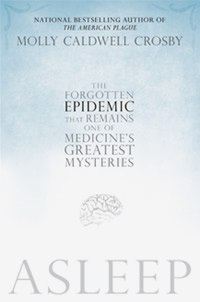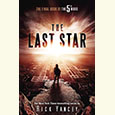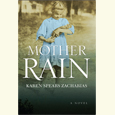Uncovering a Forgotten Epidemic
A bizarre disease that drives some victims into fatal sleep and leaves others languishing in mental illness proves a fascinating subject for Memphis author Molly Caldwell Crosby
Epidemics of encephalitis lethargica—sleeping sickness—have long inspired literature, writes Memphis-based science author Molly Caldwell Crosby in Asleep: The Forgotten Epidemic That Remains one of Medicine’s Greatest Mysteries. “Sleeping Beauty,” “Rip Van Winkle,” and “The Fall of the House of Usher” are but three well-known stories written after separate outbreaks of the mysterious illness, which can cause patients to sleep for months or years, if they ever awaken at all. Those who awaken are often profoundly changed, carrying a host of mental defects. It wasn’t until one million people died from encephalitis lethargica, during and after the great flu pandemic of 1918, that medical science began to study and understand sleeping sickness—although much about it remains unknown. The mental patients described by the neurologist Oliver Sacks in the book Awakenings, for example, also suffered from disease.
In Asleep, Crosby, author of the 2006 nonfiction bestseller The American Plague, has written a tale as timeless and disturbing as its literary predecessors. The book follows the emergence of the epidemic through seven case studies, beginning in the trenches of World War I in 1916 and ending with a final case in London in 1931; when that victim, the last known survivor of the epidemic, died in 2002, his brain became a clue in understanding it. Like Sacks before her, Crosby does a masterful job of describing the horror of a disease in which victims become trapped in bodies that won’t respond, their brains stuck in a limbo between nightmare and consciousness.
 “She could see herself present in the room, but she was not herself,” Crosby writes of her own grandmother, who contracted the disease at the age of sixteen. “She was polished somehow. Smooth and sculpted like a statue. She tried to lift her arm, but it would not move. She concentrated and tried again, but she felt as though arms, hands, legs, and feet were no longer connected to her brain, no longer accepting commands. At that point, she became frightened. An overwhelming, claustrophobic fear seized her; she was a statue.”
“She could see herself present in the room, but she was not herself,” Crosby writes of her own grandmother, who contracted the disease at the age of sixteen. “She was polished somehow. Smooth and sculpted like a statue. She tried to lift her arm, but it would not move. She concentrated and tried again, but she felt as though arms, hands, legs, and feet were no longer connected to her brain, no longer accepting commands. At that point, she became frightened. An overwhelming, claustrophobic fear seized her; she was a statue.”
It is no wonder that in addition to “Fall of House of Usher,” Edgar Allen Poe also used the disease as starting point for his claustrophobic tale, “The Premature Burial.” Asleep may be the most frightening medical read since Richard Preston’s The Hot Zone in 1994. As with Preston’s description of the Ebola virus, readers of Asleep experience twin horrors: the plight of the actual victims whose symptoms appear in the book, along with a recognition of the very real danger to the world should such an outbreak occur on a global scale today. From the case studies Crosby examines, it becomes clear that there was some mysterious connection between sleeping sickness and the flu pandemic of 1918; it might take only an H1N1 or SARS outbreak to put millions into a deadly sleep again.
With history, especially scientific history, it takes a writer with a deft touch to balance the exposition of facts with an artistic evolution of character and story. In explaining how well Crosby manages this feat, it may be worth noting a remarkable coincidence: Crosby lives in Memphis and has taught creative nonfiction at the University of Memphis, just like science author Rebecca Skloot, whose own medical mystery story, The Immortal Life of Henrietta Lacks, was published to rave reviews just a month ago, debuting on The New York Times bestseller list days after publication. Crosby holds a master’s degree in science and nonfiction writing from Johns Hopkins; Skloot holds one from the University of Pittsburgh. Both have done extensive freelance writing for science and health magazines, and comparisons between the two seem inevitable.
 Like Skloot, Crosby understands how to strike a literary balance between scientific explication and nonfiction story-telling. She has found memorable, human characters to carry her historical narrative forward. Here is Crosby describing Constantin von Economo, a World War I fighter pilot and neurologist who described the first case of the outbreak, and with great prescience determined that the disease affects the victim’s hypothalamus: “Although born in Romania, von Economo came from Greek aristocracy and married the daughter of an Austrian prince, becoming Baron Constantin von Economo. He lived a cosmopolitan life, traveling between estates in Italy and Greece and his home in Austria. His appearance was a nod to his Greek heritage—chestnut skin, dark hair parted and swept to one side, black eyes beneath heavy lids, a thick mustache that turned at the edges.”
Like Skloot, Crosby understands how to strike a literary balance between scientific explication and nonfiction story-telling. She has found memorable, human characters to carry her historical narrative forward. Here is Crosby describing Constantin von Economo, a World War I fighter pilot and neurologist who described the first case of the outbreak, and with great prescience determined that the disease affects the victim’s hypothalamus: “Although born in Romania, von Economo came from Greek aristocracy and married the daughter of an Austrian prince, becoming Baron Constantin von Economo. He lived a cosmopolitan life, traveling between estates in Italy and Greece and his home in Austria. His appearance was a nod to his Greek heritage—chestnut skin, dark hair parted and swept to one side, black eyes beneath heavy lids, a thick mustache that turned at the edges.”
Through this larger-than-life character, Crosby carries readers through the discovery of the initial case. With the book’s subsequent case studies, each doctor and researcher is as carefully portrayed as the victims. Much like Skloot, Crosby is able to weave these historic characters and fascinating science into her own personal connection to the subject matter, which ultimately gives the book an intensity and immediacy it might otherwise lack. It seems extraordinary that two of the best nonfiction narratives in years—both written on previously obscure medical topics—should emerge from Memphis at more or less the same time.
Whatever the cause of this outbreak of excellent nonfiction, readers everywhere can only hope that it is catching.
Molly Caldwell Crosby will read from and sign copies of Asleep at Davis-Kidd Booksellers in Memphis on March 2 at 6 p.m., and at Davis-Kidd Booksellers in Nashville on March 16 at 7 p.m.


